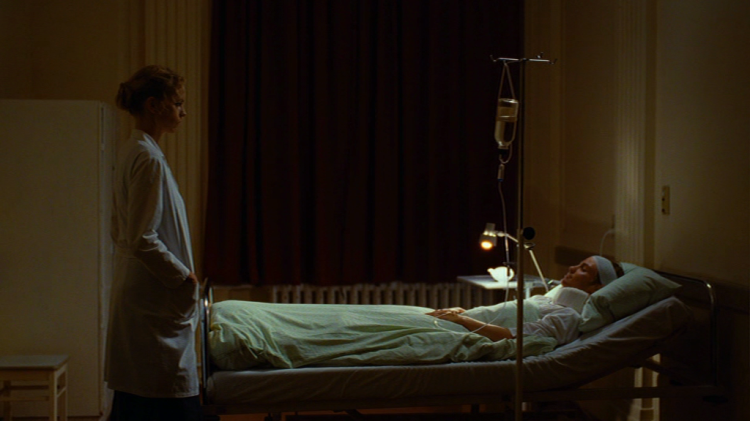2 ou 3 choses que je ne sais pas d’elle: Christian Petzold’s “Barbara”
This blog entry contains spoilers and lots of ’em.
In the opening sequence of Christian Petzold’s Barbara (2012), the title character (Nina Hoss) sits down on a bench in front of a children’s hospital and lights a cigarette while two men observe her through an open window on the second floor. When the surgeon, André (Ronald Zehrfeld), asks if she’s alone in the town, the older man Schütz (Rainer Bock) replies, “Her incarceration disintegrated her circle of friends.” Although this piece of exposition is more for our sake than André’s (evidently he already knew that she was in prison), it’s still pretty evasive in that we’re never told what she did. Accordingly, for the first half of the movie, as we observe Barbara settling into her new job at the hospital and life in a quiet small town (we learn early on that she’s from Berlin), we’re less interested in what’s going to happen next than the events leading up to the present situation.
Although Hollywood movies typically begin with a concentrated dose of exposition (the opening sequence of Casablanca [1942] is an obvious example), for viewers accustomed to watching art films, such curtness is nothing unusual — that is, until one notices that none of the characters carry cell phones or use a computer. Is this merely an oversight or has Petzold (always an austere director) consciously eliminated all superfluous elements from the mise en scène at the expense of verisimilitude? Sooner or later, an alternative hypothesis begins to take shape: The movie is a period piece but Petzold has taken his terse style to its logical conclusion by withholding the sort of clear tip offs that usually date a story — not only conspicuously old fashioned clothing and décor, but quaint pop songs and dialogue alluding to historical events. Without such clues, one can only say approximately that the story takes place some time in the 1970s or early ’80s.
As this suggests, it’s not immediately clear if the story is set in East or West Germany, though perhaps a German viewer would be able to tell faster than I did. Following her release from prison, Barbara is put under police surveillance, and there are routine searches of her apartment and her person, but she could just as likely be a member of the Red Army Faction as an East German dissident. At one point, Barbara has a rendezvous in the woods with a well dressed man, Jörg (Mark Waschke), whose slightly bellbottomed pants offer the strongest clue yet about the period. That Jörg is traveling in a Mercedes would seem to indicate that the story is set in the BRD, but while he and Barbara screw in the bushes, his companion, Gerhardt (Peter Benedict), chats with an elderly local man who’s astonished to see such a nice car (“It’s upholstered!”), and on the drive back, Gerhardt sarcastically repeats other comments the man made to him in the same vein, implying that he and Jörg are rich West Germans visiting the East for some unspecified reason.
Despite the film being so stingy with exposition, the presentation of the main action is anything but elliptical. So while a number of questions are left unanswered, in the second half of the movie, there’s a shift in emphasis from curiosity about the characters’ pasts to anticipation of future events — particularly after we learn that Jörg has made arrangements for Barbara to flee the country surreptitiously on a particular evening. When she subsequently agrees to help André with an operation the same night, it appears that she’s abandoned her plan of defecting to the West, but on the critical evening, we see Barbara sitting in her apartment as the other doctors and nurses file into the operating room while André stands by the entrance waiting for her. By this stage, the film has begun to resemble a Hollywood movie like Casablanca in which the protagonist has to choose between what they want for themselves (namely, escaping a repressive regime in order to be with the person they love) and serving a noble cause (in this case, helping children).
That said, the film’s conclusion is more open-ended than is typical for a Hollywood movie. Early in the film, a feral young girl, Stella (Jasna Fritzi Bauer), is brought into the hospital after contracting meningitis from tick bites while hiding in the forest. It’s only when Barbara asks André not to discharge Stella to keep her from being sent to a work camp that we come to understand why she was hiding in the forest and begin to form focussed hypotheses about how she became pregnant. After escaping from the work camp, Stella turns up at Barbara’s apartment on the evening she’s scheduled to flee and goes with her to the rendezvous point, but as only one of them can go, Stella leaves in her stead. Following the operation, André goes to Barbara’s apartment where the police officer, Schütz, tells him that she won’t be coming back. The next morning, however, Barbara goes to see André at the hospital, but as the movie ends there, it’s not clear if she gets gets into trouble with the police or if Stella makes it to Denmark. Just as the beginning of the film withheld information about the characters’ pasts, now the ending withholds information about their futures.
